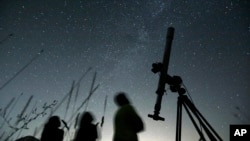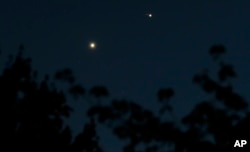All seven major planets form a kind of parade in the sky at the end of February. Although two of the planets are not visible to the unaided eye, all are on the same side of the sun during the evening hours.
This planetary grouping happens when the planets appear to line up in the night sky as seen from Earth. They do not form a straight line, but they do stretch across the evening sky this year.
The American space agency, NASA, says these astronomical gatherings are common. A parade of four or five planets visible to the unaided eye happens every few years.
A similar parade took place last June, but only two planets could be seen without the use of special equipment. Six planets were visible in January. Four were visible to the unaided eye. In recent weeks, Mercury joined the group.
Venus, Mars and Jupiter are all easily visible in the evening. Saturn is now very close to the setting sun and Mercury is close to the horizon, making both hard to see. Uranus and Neptune are the most distant planets. Uranus can be glimpsed with binoculars or a telescope under good conditions. But Neptune is now too close to the sun to be seen.
Seeing the brightest planets is easy. Go outside on a clear night after sunset. The planets will shine brighter than the stars. Mars is a bright, reddish-orange light appearing high in the constellation Gemini. Jupiter is very bright and a little lower than Mars toward the constellation Taurus.
Venus, in the constellation of Pisces, is the brightest natural object in the sky besides the sun and moon.
There are many stargazing apps available that can help identify the planets and bright stars.
The planets will slowly move lower and lower in the west throughout the spring.
I’m Mario Ritter, Jr.
Adithi Ramakhrishnan reported this story for the Associated Press. Mario Ritter, Jr. adapted it for VOA Learning English.
____________________________________________________
Words in This Story
visible –adj. able to be seen by the eye
horizon –n. where the sky apparently meets the land
glimpse –v. to see something for a short time or with some difficulty
constellation –n. a group of stars that is defined by international scientific agreement
app (application) –n. a computer program for a specific purpose







Forum